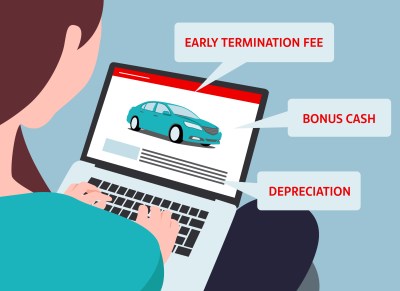
I recently had a meeting with some web developers. While I knew they were speaking English, I had no idea what they were saying.
Jargon can be very frustrating, especially if you’re leasing a car. Understanding what you’re reading and hearing can be a total gamechanger.
With that in mind, it might be a good idea to remember some key terms if you’re in the market to lease a new vehicle. This quick guide can help you understand things when you’re at the dealership.
Acquisition Fee: An acquisition fee is sometimes charged to cover some of the costs involved in setting up a lease.
Bonus Cash: Bonus cash, sometimes known as customer cash, is a type of rebate that is sometimes available on select makes/models for a limited period of time. It is used to reduce the purchase price of a vehicle.
Capitalized (Cap) Cost: The cap cost refers to agreed-upon purchase price of the vehicle after discounts, fees and down payments are applied.
Capitalized (Cap) Cost Reduction: Cap cost reduction is any funds (down payment, bonus cash, etc.) listed on the lease agreement that reduces the cost of financing.
Depreciation: Depreciation means how much value your vehicle loses each year.
Destination Charge: This is a fee that’s charged for getting the vehicle to the dealership from wherever it was manufactured. It’s normal for this fee to be passed to you as a consumer.
Early Termination Fee: These are charges you pay at the end of the lease if you turn the vehicle in before the lease term is over.
Guaranteed Asset Protection (GAP) Coverage: You can choose to purchase GAP when you finance a vehicle. (GAP is included on all Santander Consumer USA lease contracts.) If you purchased GAP and your vehicle is ever stolen or destroyed, GAP pays the difference between what is owed and what the vehicle is worth.
Lessee: When leasing, you are the lessee. As the lessee, you drive the vehicle and are responsible for making payments on the lease until the lease term expires.
Lessor: The lessor lends you the money for the lease, and they own the vehicle you’re driving.
Mileage Allowance: The amount of miles you can drive the car without incurring additional mileage charges. All leases have a mileage allowance.
Mileage Charges: These are extra charges you have to pay if you go over your lease term mileage allowance.
Money Factor: The money factor represents the cost of borrowing for a lease. It’s like the interest rate on a car loan. You multiply the money factor by 2,400 to approximate your interest rate.
Residual Value: When your lease term is up, the car has some remaining value. This is called residual value.
Understanding what you’re reading and signing can change your leasing experience. Keep in mind that the salesperson and the finance manager are there to help you understand. You should feel comfortable when you’re deciding on a vehicle. That includes understanding what your contract says and some of the jargon you might hear.



